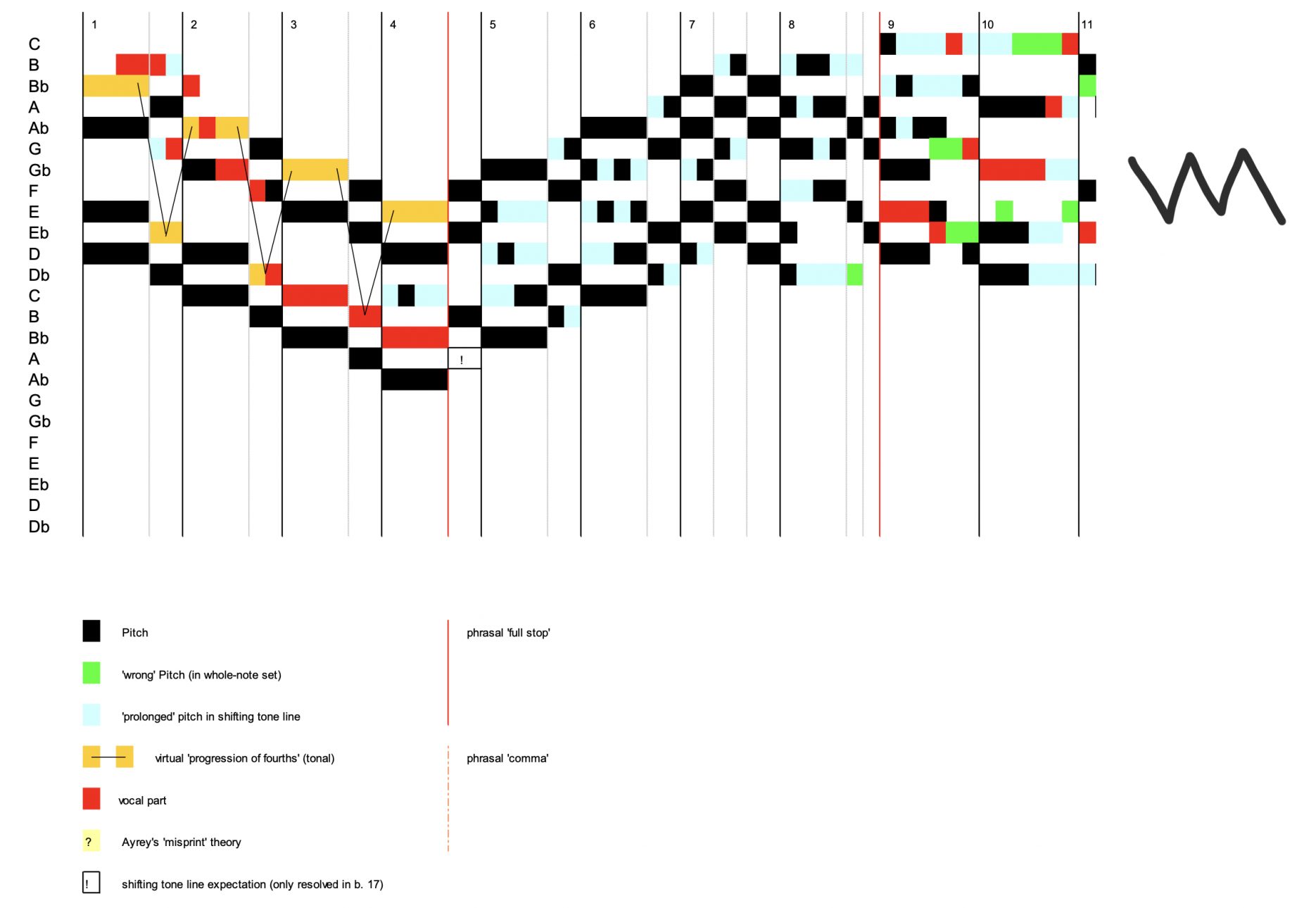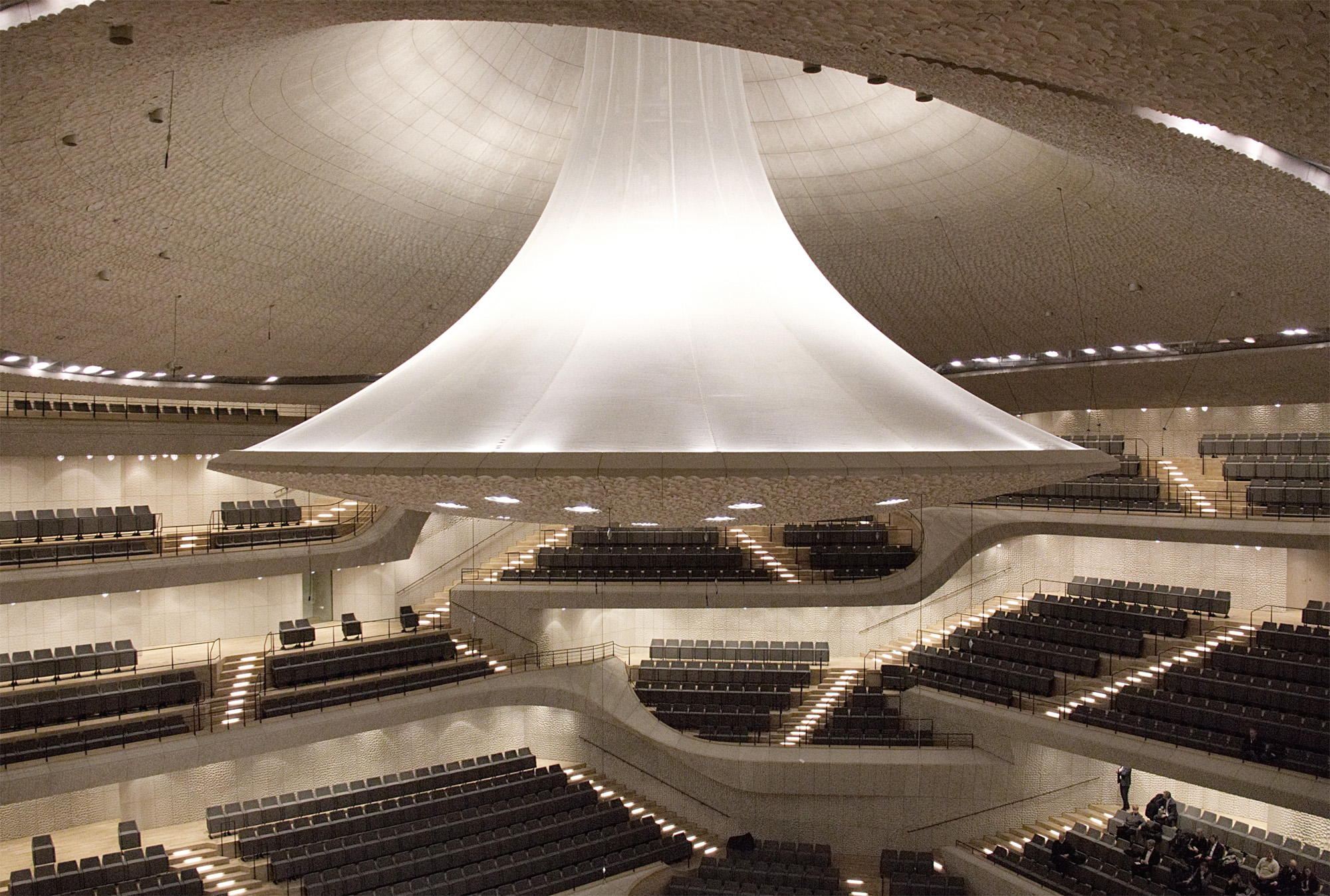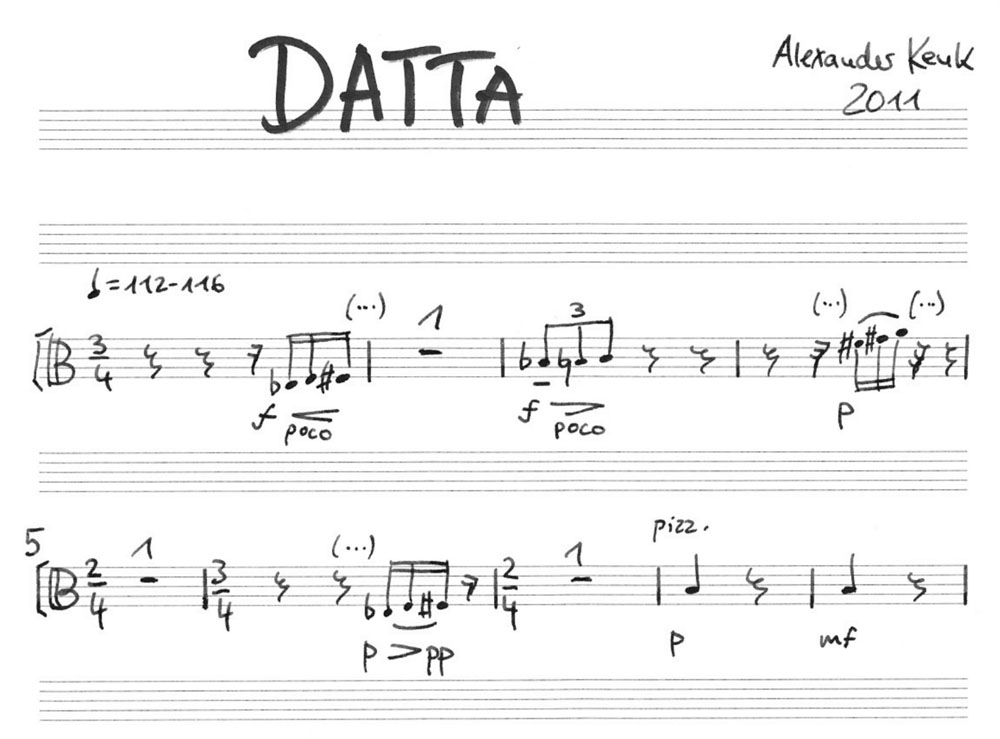With this music analysis, I present an entirely different approach to Alban Berg’s opus 2/ii. It recognises Craig Ayrey’s idea of opposing whole tone sets as well as Perle’s assumption of the cycle of fourths functioning subliminally as implied underlying tonality. However, the underlying principles of “Schlafend trägt man mich in mein Heimatland” neither are based on a tonal centre, nor rely on whole tone sets as a vertical structuring of the piece, although one clearly has to take into account somehow ‘tonal’ expectations of the listener, whether he “believes in the organic coherence of the masterwork” (as Edward Laufer puts it) or not.
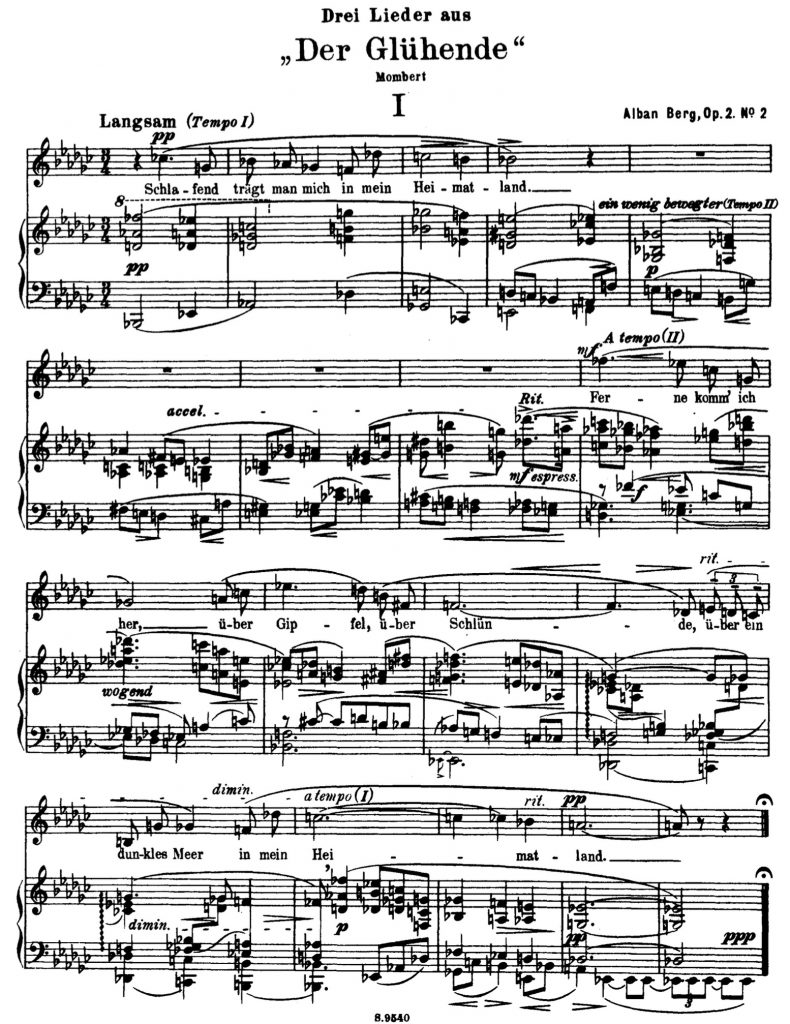
At the edge of tonality, what is the environment which gives form to the development of the piece? I suggest that in op. 2/ii, it is a system of derived forms of a basic pitch class set and an interfering pseudo-tonal melody, demanding attention with the words “Ferne komm’ ich her”. Craig Ayrey mentions that
“the concept Heimatland is exclusively associated with the tonally indefinite whole-tone chords and is set in opposition to ferne which appears dramatically, because unusually, with the stable Eb triad.”
I regard that subtext essential for the understanding of the piece, although I do not think that the melodic line fb – eb – c – g – gb should be taken for a stable Eb triad. It rather offers a wrong track that plays with the listener’s expectation and pretends to be tonal, proving that the new system is still unstable and easily to interfere. Rather unusual I regard the fact that the Heimatland is obviously still an indefinite (‘whole-tone’) region, far at the horizon; it might be just a fata morgana, slowly but constantly shifting with expectation; a distorted image in the mind of a thirsting wanderer.
Using “new techniques of tonal organization”, the Berg Lied is still searched by Ayrey and others for a “tonal background”, mainly because of the progression of fourths in the first bars and the “almost explicit Eb chord in b. 9” – and perhaps because this approach might authorise the music theorist to apply principles like prolongation, Auskomponierung, foreground/background etc. – and then leading to a statement of which of these principles might still work and which might not.
What are, however, the basic principles of the organisation of tones in the Lied? Referring to Schönberg’ s discussion of ‘systematic symmetries’ in his Harmonielehre, the initial chord (which is obviously not meant to be an altered French 6th) can be taken for a ‘symmetrical’ pitch class set. The piece then develops the whole system of chords by a linear, chromatic progression:
The basic pitch class set forms the beginning of the song. In its vertically symmetrical appearance, it consists basicly of a whole tone, a major third, and another whole tone. Another semi-tone is then added to this set on top (in the vocal part), which, assuming that the pitch class system consists of opposing whole-tone groups, can be taken for a pre-occurance to the new whole-tone set up on the last beat of the bar. The same whole-tone set obviously re-occurs in the last two bars of the Lied, forming a perfect frame; a relation to op.2/iii is therefore not necessary. If we assume ‘temporal’ prolongations as possible between neighbouring pitch class sets, we can track the chromatic progression of this pitch class set throughout the whole first phrase of the piece (b. 1-8), and the revision of this principle at least in the last phrase (b.14ff.).
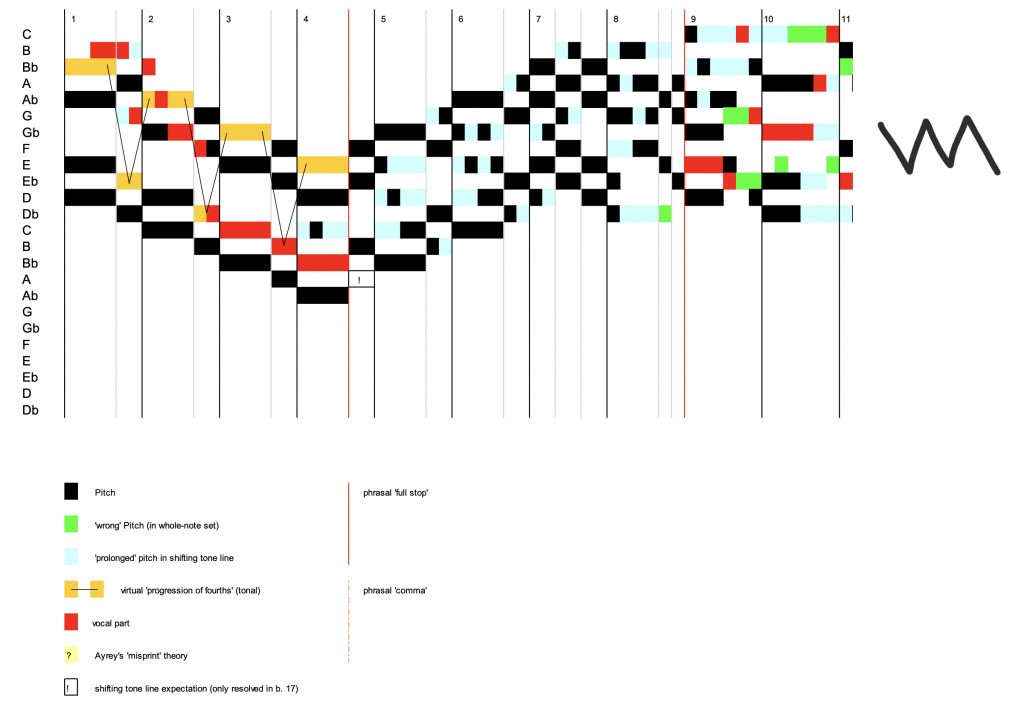
Taken on a wrong ‘tonal’ track by the progression of fourths in the beginning of the piece, it is only later that we discover that they are just a part of a constantly shifting process which steadily underlines the whole pitch class progression. It is veiled by changes of register in melody and accompaniment, and by almost promiscuous use of the different parts of the pitch class set by single voices.
These shifting processes seem to have a clear direction, being rather in a steady movement than using any Auskomponierung or unfoldings. This process is only disturbed by the pseudo-tonal interferences in b. 9ff. Immediately, the shifting progress seems to come to a hold, and it is now difficult to differentiate whole-tone sets, for the symmetric tonality is blurred by ‘wrong’ pitches which form the tonal remembrance. But then the focus of the singer changes from looking backwards to looking forwards again (“Ferne komm ich her // in mein Heimatland”), and the pace moves on, this time in a descending direction, until it comes to a final hold on the original pc set in b. 17.
Right from the beginning, the listener’s attention is drawn to what they might regard as tonal relicts. The actual process of chromatic pitch class movement via semitones is superimposed by greater intervallic steps suggesting a tonal progression and even dominant dependance and resolution. It is, however, a pseudo-tonality, because it is only the outward experience of a non-functional pitch class progression. Only that the listener is driven into actual perception of functional links between the ‘chords’! That this process is an infinite one, one actually discovers in the last bars, when in the recapitulation of the initial melody, an A is added to the semitone descent – and further tones could be added in the descent.
It may be necessary once more to explain what I mean with progression and prolongation in this particular type of development. Prolongation in general is not used in its Schenkerian sense, as a linear unit ‘prolonging’ a harmonic unit. It is just a device to mentally connect whole-tone sets in their semi-tone progression over a very short period of time, i.e. three quavers at the most, so that one is able to trace the whole process in the piece also in bars, where obviously pitches are ‘missing’ (as in b. 8). In this context, it might be worth mentioning that Berg might also have thought of at least one extended prolongation, or rather a consequently resolved promise, when omitting the ♮A in bar 4 (the semi-tone progression is interrupted there), but providing it as a result – or rather part of the infinite descent, as I mentioned earlier – of the development of the vocal part. Neither the Schenkerian concept of passing and neighbour notes nor “background bass progression [in] a perfect-cadence form” are applicable in this context any more.
(2002)
Bibliography
Adorno, T. W. “Alban Berg – Master of the smallest link” (transl. by Brand, Juliane & Christopher Hailey). Cambridge: Cambridge University Press, 1991 (G: 1968).
Ayrey, Craig. “Berg’s ‘Scheideweg’: Analytical Issues in Op. 2/ii”. In Musical Analysis 1: 2, 1982. 189-202. [Ayrey]
Eggebrecht, Hans Heinrich. Musik im Abendland: Prozesse und Stationen vom Mittelalter bis zur Gegenwart. München: Piper, 1991. pp. 777-793.
Forte, Allan. The Structure of Atonal Music. New Haven: Yale University Press, 1973.
Perle, George. Serial Composition and Atonality: An Introduction to the Music of Schoenberg, Berg, and Webern. 6th ed. Berkeley: University of California Press, 1991.
